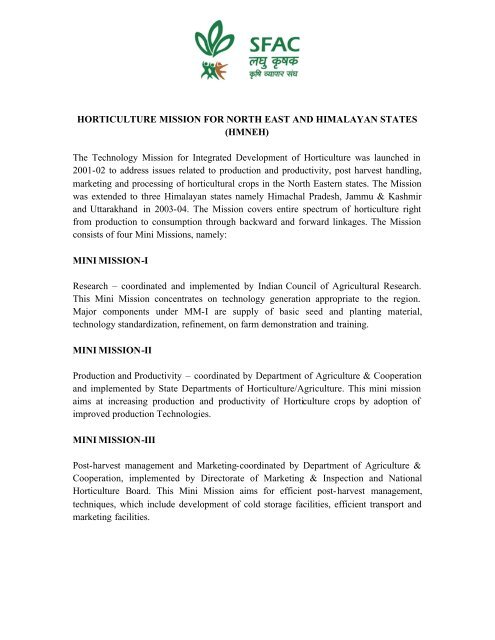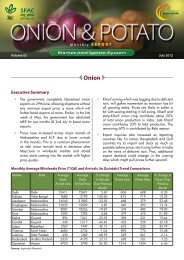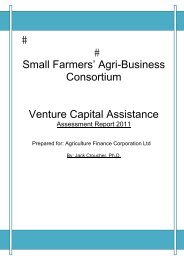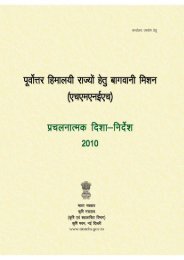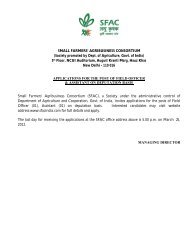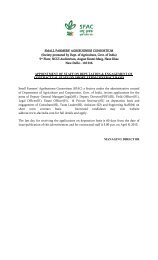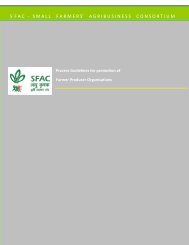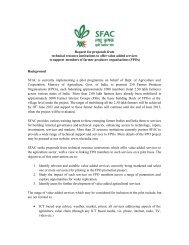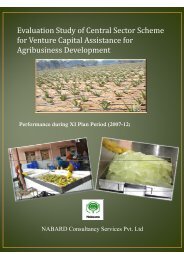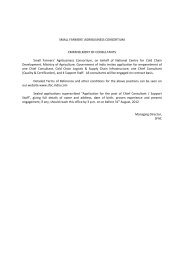EOI Guidelines - SFAC
EOI Guidelines - SFAC
EOI Guidelines - SFAC
Create successful ePaper yourself
Turn your PDF publications into a flip-book with our unique Google optimized e-Paper software.
HORTICULTURE MISSION FOR NORTH EAST AND HIMALAYAN STATES<br />
(HMNEH)<br />
The Technology Mission for Integrated Development of Horticulture was launched in<br />
2001-02 to address issues related to production and productivity, post harvest handling,<br />
marketing and processing of horticultural crops in the North Eastern states. The Mission<br />
was extended to three Himalayan states namely Himachal Pradesh, Jammu & Kashmir<br />
and Uttarakhand in 2003-04. The Mission covers entire spectrum of horticulture right<br />
from production to consumption through backward and forward linkages. The Mission<br />
consists of four Mini Missions, namely:<br />
MINI MISSION-I<br />
Research – coordinated and implemented by Indian Council of Agricultural Research.<br />
This Mini Mission concentrates on technology generation appropriate to the region.<br />
Major components under MM-I are supply of basic seed and planting material,<br />
technology standardization, refinement, on farm demonstration and training.<br />
MINI MISSION-II<br />
Production and Productivity – coordinated by Department of Agriculture & Cooperation<br />
and implemented by State Departments of Horticulture/Agriculture. This mini mission<br />
aims at increasing production and productivity of Horticulture crops by adoption of<br />
improved production Technologies.<br />
MINI MISSION-III<br />
Post-harvest management and Marketing-coordinated by Department of Agriculture &<br />
Cooperation, implemented by Directorate of Marketing & Inspection and National<br />
Horticulture Board. This Mini Mission aims for efficient post-harvest management,<br />
techniques, which include development of cold storage facilities, efficient transport and<br />
marketing facilities.
MINI MISSION-IV<br />
Processing-coordinated and implemented by Ministry of Food Processing Industries,<br />
Government of India. This Mini Mission aims at promoting processing industry for value<br />
addition to Horticultural produce by promoting new processing units and up gradation of<br />
existing units. Technology Mission Cell at Department of Agriculture & Cooperation,<br />
Headquarter coordinates with Central Ministries/ Departments/ State Governments/ other<br />
agencies involved in implementation of the Mission. The T.M cell is responsible for<br />
budget formulation, release of fund to <strong>SFAC</strong> and other agencies, obtaining approval of<br />
proposals at appropriate level and preparation of consolidated reports. All these functions<br />
come under the overall supervision of Horticulture Commissioner.<br />
Financial achievement<br />
During the years 2001-02 to 2009-2010, an amount of `1863.83 crores has been released<br />
under the Mission, of which `1370.70 crores for NE states and `493.13 crores for<br />
Himalayan states.<br />
During the year 2009-2010, an amount of `359 crore was earmarked and an amount of<br />
`325.72 crore was released under the mission, out of which `248.23 crore has been<br />
released to North Eastern states and `77.49 crore to Jammu & Kashmir, Himachal<br />
Pradesh and Uttrakhand.<br />
Physical achievement<br />
The implementation of the mission since inception of the scheme upto 2009-10 has<br />
helped in bringing in an additional area of 528748 ha under various horticulture crops in<br />
the states. Of this fruits contributed 287516 ha, vegetables 104202 ha, spices including<br />
saffron 74485 ha, plantation crops (cashew) 14111 ha, medicinal 6464 ha, aromatic<br />
plants 10183 ha, flowers 30468 ha, root & tubers crops 1319 ha. In addition, 36968 ha of<br />
senile and unproductive orchards have been rejuvenated to increase productivity. Major<br />
infrastructure which has come up under the mission includes 1017 nurseries, 11177<br />
community tanks and 14583 tube wells. Drip irrigation has been extended to 15751 ha.<br />
Twenty seven model floriculture centers and 57 herbal gardens have been established.<br />
Besides this, 27 tissue culture units and 22 disease forecasting unit have also been setup.<br />
Mission gave special thrust to high value crops like tomato capsicum, strawberry and<br />
flowers to ensure production of quality produce. More than 8.5million sq m of protected<br />
cultivation has been established in these regions. So far 5927 power tillers, 65775<br />
manually operated machines, 12748 power operated implements and 13276 diesel<br />
engines have been distributed under the mission. For proper handling and marketing of<br />
horticulture produce, 47 whole-sale markets, 344 rural primary market/apni mandis, 35<br />
cold storage, 65 processing units and 18 state grading laboratories have been established.<br />
During the period under report, an additional area of 93757 ha has been brought under<br />
different horticultural crops. Of this, fruits contributed 44454 ha, vegetables 27270 ha,
spice including saffron 10683 ha, medicinal & aromatic plants 1928 ha, plantation crops<br />
3368 ha, root & tubers 449 ha, flowers 5538 ha, etc. In addition, 7081 ha of senile and<br />
unproductive orchards have been rejuvenated for further higher production. Besides,<br />
infrastructure facilities such as 59 model nurseries, 1192 community tanks, 3631 tube<br />
wells, 764312 sq m of greenhouses, 6 model floriculture centers, 2 mushroom units, 32<br />
rural primary markets/ apni mandis and 16 processing units have been established. Under<br />
Human Resource Development activity 37121 farmers/ officers including women farmers<br />
have been trained on various aspects of horticulture.<br />
Review of past performance<br />
• ??After launching of the Technology Mission on Horticulture, additional area of<br />
528748 ha have been brought under Horticulture crops, till 2009-10.<br />
• ??The mission has brought about transformation in the production scenario while<br />
in the pre-mission period, horticulture production was largely of the nature of key<br />
chain cultivation or taking cash crops for supplementing farm income, these are<br />
now being commercially cultivated. The additional area brought under various<br />
horticulture crops is direct impact of this support and realize high productivity<br />
level. The overall impact of the mission is quite visible in terms of increased level<br />
of awareness about the rule of agricultural sector in the economic of the region.<br />
The vegetable scenario has started giving quick seasonal economic returns to<br />
farmers. Commercial cultivation of flowers such as orchids, anthorium, lilium,<br />
roses etc has improved the economy of many farmers besides providing ample<br />
employment opportunities for many youth especially women.<br />
• ??Large number of farmers from all the states have been given exposure of<br />
Horticulture Development programmmes outside the state, so as to familiarize<br />
them with latest technologies being employed by other developed states. Farmers'<br />
training under the mission is a key programme for ushering in Horticulture<br />
Development in the region.<br />
• ??There is wide appreciation of the manner in which the Technology Mission<br />
Programmes have been conceived and are being implemented. The overall impact<br />
of the Mission is also very much visible in terms of increased level of awareness<br />
about the role of horticulture sector in the economy of the region.<br />
• ??Some states like Mizoram and Manipur have made an impressive progress in<br />
vegetables, cultivation of second crop in a year after paddy, adopting cluster<br />
approach, thus helping the growers to earn better returns from same unit area of<br />
land. Technology Mission has made a significant change in the cropping pattern<br />
and returns from the land.<br />
• ??In ornamental crops, major success has been observed in promoting Anthorium<br />
in Mizoram using planting material imported from abroad through private<br />
company. The company provides planting material and also know-how for<br />
growing under protected cover. The farmers in the state are highly enthusiastic<br />
about this, which can be treated as a success story of the Mission.
• ??The infrastructure facilities created such as nurseries, tissue culture units,<br />
community water tanks, tube wells, drip irrigation, greenhouses, model<br />
floriculture centre, mushroom units, vermi-compost units etc. have helped in<br />
production and supply of quality planting material and also improving production<br />
and productivity of horticulture crops in the region.<br />
• ??Infrastructure facilities were also created for improved post harvest<br />
management, marketing as well as processing of horticultural produce in these<br />
states. These activities have helped in improving the economy of a majority of the<br />
inhabitants of the region, mainly small and marginal farmers.<br />
Outstanding Challenges<br />
While HMNEH has chalked up some impressive achievements in terms of expansion of<br />
area and range of horticulture produce, three critical challenges remain to be effectively<br />
tackled:<br />
1. Strong marketing linkages within and beyond the region to the national and export<br />
markets for the wide variety of horticulture produce.<br />
2. Use of modern farm equipment to enhance the productivity of farmers<br />
3. Solutions for community based, low cost organic/GAP certification to add value<br />
to the horticulture produce of the north eastern and hill states targeted by<br />
HMNEH<br />
<strong>SFAC</strong> has been mandated by Dept. of Agriculture, Govt. of India to find solutions to the<br />
above three challenges. <strong>SFAC</strong> invites private and public sector companies, research<br />
institutions, original equipment manufacturers, civil society organisations and any other<br />
interested party, to offer pilot proposals for solutions to any or all the above issues. Even<br />
individual or groups of individuals are eligible to submit proposals. Proposals are invited<br />
in the form of pilots covering one or more districts in one or more states covered by<br />
HMNEH. Successful proposals vetted by a technical committee will be eligible for 100%<br />
funding support, based on specific deliverables. Based on performance, effective pilots<br />
will be upscaled with financial support by Govt. of India in the entire region.<br />
<strong>Guidelines</strong> for submission of proposals<br />
• Part I of the proposal should be a brief profile of the organization; full details of<br />
current and past work profile, list of major projects undertaken, expertise in the<br />
area for which proposal is being submitted, previous work in region/State (if any),<br />
list of technical personnel in organization, copy of last annual audited accounts<br />
available.<br />
• Part II of the proposal will cover the technical part of the proposal: describe the<br />
problem which you want to address (i.e. either marketing, or mechanization or<br />
certification or a combination thereof); the area to be targeted by the pilot (it must<br />
be at least one district at the very minimum); the details of the intervention; the<br />
likely outputs and outcomes; the measurable deliverables and the timelines.
• Part III of the proposal should contain details of the financial outlay, with<br />
itemized budgeting for the various components of the pilot. A maximum of 8%<br />
will be allowed as administrative overhead.<br />
Proposals complete in all respects must reach the undersigned at the postal address given<br />
in the form of one single packet by 5 p.m. on 21 st June 2011. The packet should be<br />
superscribed in bold letters: PROPOSAL FOR HMNEH.<br />
No proposal will be received through e-mail or in electronic form. No earnest money is<br />
required at this stage.<br />
The decision of the undersigned to accept or reject any or all proposals will be final and<br />
no reasons for the same will be provided.<br />
Managing Director<br />
Small Farmers’ Agribusiness Consortium (<strong>SFAC</strong>)<br />
5 th Floor, NCUI Auditorium<br />
August Kranti Marg, Hauz Khas<br />
New Delhi 110016


